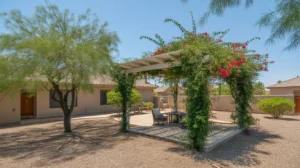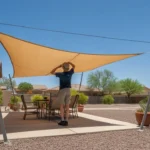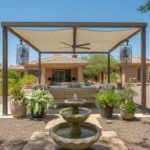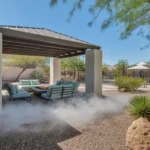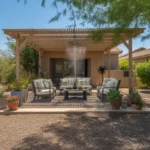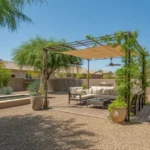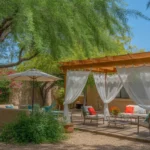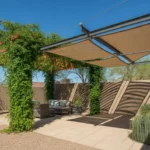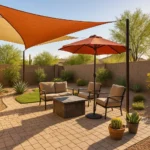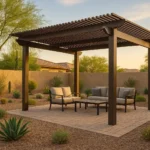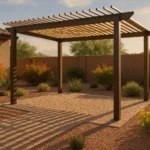As the scorching Arizona sun beats down on Southeast Valley patios, finding ways to create natural shade becomes a top priority for outdoor comfort. By incorporating strategic shade techniques, you can transform your patio into a cool, inviting oasis that defies the summer heat. Let’s explore some effective natural shade solutions to help you enjoy your outdoor space all season long.
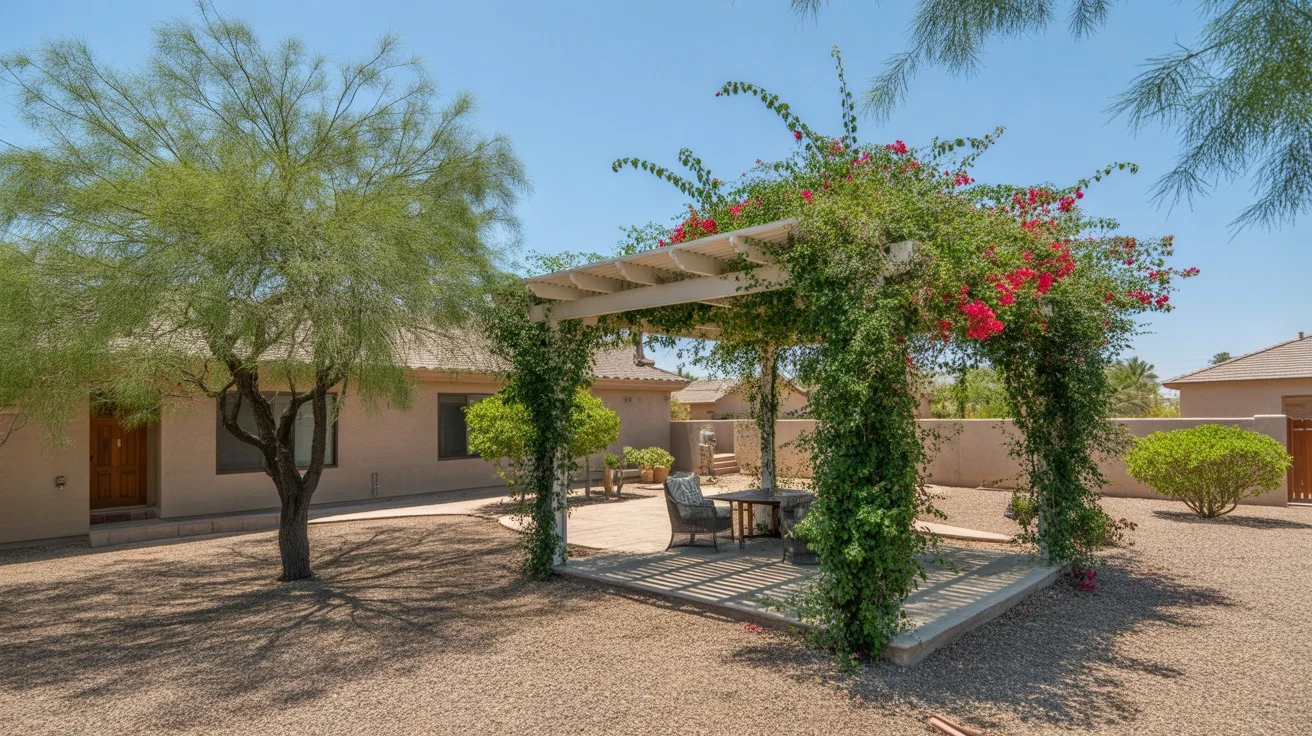
Harness the Power of Shade Trees
One of the most impactful ways to cool your Southeast Valley patio is by planting shade trees. Carefully selected trees can provide a canopy of relief from the intense sun, creating a naturally cooler microclimate beneath their branches. When choosing shade trees for your patio, consider species well-adapted to the local climate, such as Desert Willow, Palo Verde, or Mesquite.
To maximize the cooling effect, position your shade trees strategically around your patio. Planting on the south and west sides can block the harshest afternoon sun, while an eastern tree can provide welcome morning shade. As the trees mature, their expansive canopies will cast refreshing shadows across your patio, making it a pleasant spot to relax even on the hottest days.
In addition to their cooling benefits, shade trees also enhance the aesthetic appeal of your outdoor space. Their lush foliage adds a touch of natural beauty, while their trunks and branches create interesting visual textures. Plus, many desert-adapted trees produce stunning seasonal blooms, adding pops of color to your patio landscape.
Create Shade with Pergolas and Arbors
If you’re looking for a more structured approach to patio shade, consider installing a pergola or arbor. These architectural features provide a framework for climbing plants, which can grow into a living canopy over your patio. As the plants mature, their foliage filters the sunlight, creating a dappled shade effect that reduces heat and glare.
When selecting plants for your pergola or arbor, opt for vigorous climbers that thrive in the Southeast Valley climate. Bougainvillea, with its vibrant blooms and dense foliage, is a popular choice. Other options include Queen’s Wreath, Trumpet Vine, or even grapevines for a touch of edible landscaping. As these plants intertwine with the structure, they create a stunning focal point while providing natural shade.
To ensure your pergola or arbor delivers optimal shade, consider the orientation and placement. Align the structure to intercept the sun’s rays during the hottest parts of the day, typically the afternoon in the Southeast Valley. By angling the beams or incorporating adjustable louvers, you can fine-tune the shade coverage to suit your needs throughout the seasons.
Embrace Vertical Gardening
Vertical gardening is another clever way to introduce shade to your Southeast Valley patio. By training vines or climbing plants up trellises, walls, or screens, you can create a living barrier that blocks the sun’s harsh rays. This approach not only cools the patio but also adds a lush, verdant ambiance to your outdoor space.
When selecting plants for vertical gardening, consider their growth habits and shade-providing potential. Fast-growing vines like Cat’s Claw or Creeping Fig can quickly cover a trellis, creating a dense screen of foliage. For a more sculptural look, try training Bougainvillea or Jasmine along a wall-mounted wire system, allowing their stems to create intricate patterns as they grow.
Vertical gardens offer the added benefit of privacy, shielding your patio from curious neighbors or passersby. As the plants grow and fill in, they create a secluded retreat where you can unwind in the cool shade. Plus, the greenery helps purify the air and reduce ambient temperatures, enhancing the overall comfort of your patio.
Incorporate Shade Sails and Canopies
For a modern and versatile shade solution, consider installing shade sails or canopies over your Southeast Valley patio. These lightweight, tensioned structures are designed to block the sun’s rays while allowing air to circulate freely, creating a cooler, more comfortable outdoor environment.
Shade sails come in various shapes, sizes, and colors, allowing you to customize the look to complement your patio’s style. By strategically positioning the sails, you can create overlapping layers of shade that adapt to the sun’s movement throughout the day. This flexibility ensures that your patio remains shaded and cool, no matter the time or season.
When selecting shade sail materials, opt for high-quality, UV-resistant fabrics that can withstand the intense Arizona sun. Look for options with a high shade factor, as they will block more sunlight and heat. Additionally, consider the sail’s color carefully—lighter hues reflect more heat, while darker shades provide a deeper sense of cool relief.
Cooling Mist and Water Features
Incorporating water elements into your patio design can provide an extra layer of cooling comfort. Strategically placed misting systems or fountains can help lower the surrounding air temperature through evaporative cooling, creating a refreshing oasis amidst the desert heat.
Misting systems work by releasing fine droplets of water into the air, which evaporate and absorb heat, resulting in a noticeable temperature drop. These systems can be integrated into pergolas, arbors, or even standalone poles, providing targeted cooling in seating areas or high-traffic zones on your patio.
Water features like fountains or cascading waterfalls also contribute to a cooler patio environment. As the water circulates and evaporates, it releases cooled air into the surrounding space. The soothing sound of trickling water adds a tranquil ambiance, making your patio feel like a true desert oasis.
Reflective Hardscaping Materials
The materials you choose for your patio’s hardscaping can play a significant role in its overall temperature. Traditional dark-colored pavers or concrete can absorb and radiate heat, making your patio feel like a furnace during the peak of summer. However, by opting for reflective hardscaping materials, you can minimize heat absorption and keep your patio cooler.
Light-colored pavers, such as those in shades of sand or pale gray, reflect more sunlight and heat, reducing the surface temperature of your patio. Similarly, opting for cool decking materials like light-hued composite or natural stone can help maintain a more comfortable temperature underfoot.
In addition to color, consider the texture and porosity of your hardscaping materials. Porous surfaces, like permeable pavers or gravel, allow moisture to evaporate, contributing to a cooling effect. By combining reflective colors with moisture-wicking textures, you can create a patio surface that stays cooler and more pleasant to walk on, even during the height of summer.
Conclusion
Creating a cool and inviting patio in the Southeast Valley requires a strategic approach to shade. By harnessing the power of nature through shade trees, pergolas, vertical gardens, and cooling water features, you can transform your outdoor space into a refreshing retreat. Complementing these natural shade techniques with thoughtful hardscaping choices and modern shade structures ensures that your patio remains comfortable and enjoyable, no matter how high the temperatures soar.
As you implement these shade solutions, remember to consider your patio’s unique layout, sun exposure, and personal style preferences. By tailoring the techniques to your specific needs, you can create a personalized oasis that offers respite from the desert heat. So go ahead, savor the shade, and relish in the cool comfort of your transformed Southeast Valley patio.

